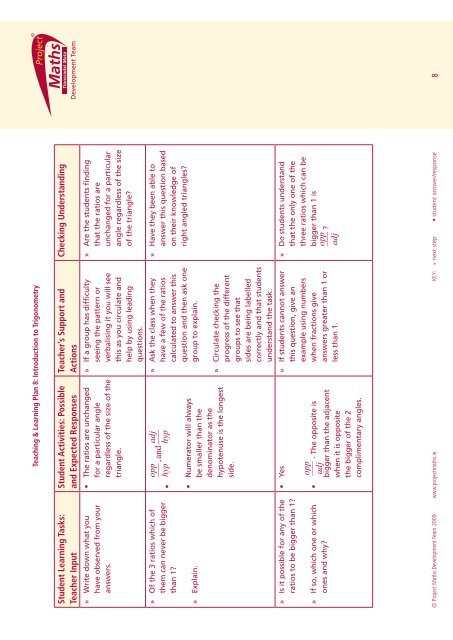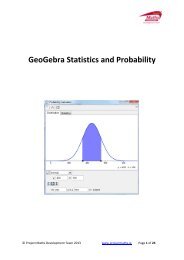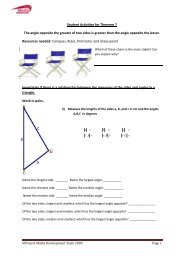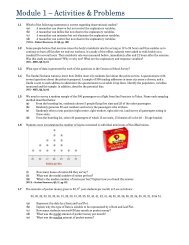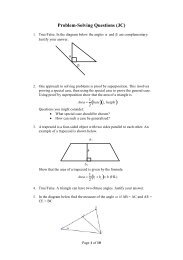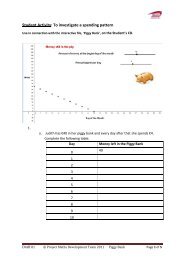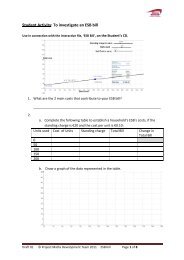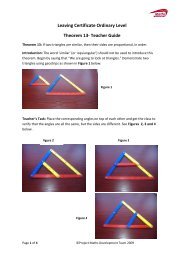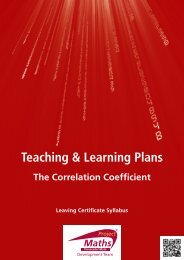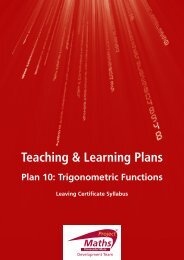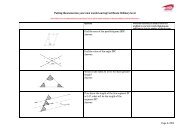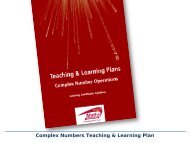Teaching & Learning Plan 8: Introduction to ... - Project Maths
Teaching & Learning Plan 8: Introduction to ... - Project Maths
Teaching & Learning Plan 8: Introduction to ... - Project Maths
You also want an ePaper? Increase the reach of your titles
YUMPU automatically turns print PDFs into web optimized ePapers that Google loves.
© <strong>Project</strong> <strong>Maths</strong> Development Team 2009 www.projectmaths.ie KEY: » next step • student answer/response 8<br />
<strong>Teaching</strong> & <strong>Learning</strong> <strong>Plan</strong> 8: <strong>Introduction</strong> <strong>to</strong> Trigonometry<br />
Student <strong>Learning</strong> Tasks:<br />
Teacher Input<br />
»» Write down what you<br />
have observed from your<br />
answers.<br />
»» Of the 3 ratios which of<br />
them can never be bigger<br />
than 1<br />
»»<br />
Explain.<br />
»» Is it possible for any of the<br />
ratios <strong>to</strong> be bigger than 1<br />
»» If so, which one or which<br />
ones and why<br />
Student Activities: Possible<br />
and Expected Responses<br />
• The ratios are unchanged<br />
for a particular angle<br />
regardless of the size of the<br />
triangle.<br />
•<br />
• Numera<strong>to</strong>r will always<br />
be smaller than the<br />
denomina<strong>to</strong>r as the<br />
hypotenuse is the longest<br />
side.<br />
• Yes<br />
• - The opposite is<br />
bigger than the adjacent<br />
when it is opposite<br />
the bigger of the 2<br />
complimentary angles.<br />
Teacher’s Support and<br />
Actions<br />
»» If a group has difficulty<br />
seeing the pattern or<br />
verbalising it you will see<br />
this as you circulate and<br />
help by using leading<br />
questions.<br />
»» Ask the class when they<br />
have a few of the ratios<br />
calculated <strong>to</strong> answer this<br />
question and then ask one<br />
group <strong>to</strong> explain.<br />
»» Circulate checking the<br />
progress of the different<br />
groups <strong>to</strong> see that<br />
sides are being labelled<br />
correctly and that students<br />
understand the task.<br />
»» If students cannot answer<br />
this question, give an<br />
example using numbers<br />
when fractions give<br />
answers greater than 1 or<br />
less than 1.<br />
Checking Understanding<br />
»» Are the students finding<br />
that the ratios are<br />
unchanged for a particular<br />
angle regardless of the size<br />
of the triangle<br />
»» Have they been able <strong>to</strong><br />
answer this question based<br />
on their knowledge of<br />
right angled triangles<br />
»» Do students understand<br />
that the only one of the<br />
three ratios which can be<br />
bigger than 1 is


